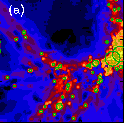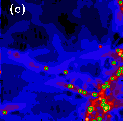
Research Interests:
Structure Formation

|

|
A combination of observations, analytic studies, and numerical simulations have now essentially confirmed our basic paradigm of structure formation. Tiny fluctuations in the matter density (generated at inflation) grow through gravitational instability. Asymmetries in the growth mean that collapse occurs first along a single axis, creating a "pancake" or sheet, then along a second axis, forming a filament, before finally collapsing fully to form a galaxy or galaxy cluster. The resulting picture has a "cosmic web" of filaments with galaxies sitting at their intersections; the two panels above show simulations of the cosmic web as it might be seen in Lyman-alpha emission.
Although the basic properties of this model are now well-understood, many questions do remain. Some of these are: